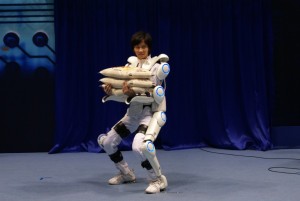2015-1203: Noodles behind bars
Apropos of our session today on ramen as a Japanese food, Alyssa mentioned a recent NPR interview show on a new book on “Prison Ramen” by Clifton Collins, Jr. and Gustavo “Goose” Alvarez.

2015-1201: Using Google Analytics to track Japan’s global image with keywords
The Japan Times has a column today on the use of Google Analytics (including Google Trends and Google Ngram Viewer) as a proxy for tracking Japan’s image in the world.The author is specifically comparing the relative appearance over time of searches for and references to “samurai” versus “Hello Kitty.” The inferences are dubious but it’s fun to perform your own searches if you follow the links in the article to Google Trends and Ngram Viewer.)
2015-1201: “Samurai Smartphone Parade”
The Japanese mobile carrier company NTT DoCoMo released a satirical video short warning against walking while using your smartphone. [There’s even a Japanese slang term for this, aruki sumaho.] The satire is set in Tokugawa times and features a procession of samurai bearing their domain lord. It’s here on YouTube.
2015-1126: “Japan recognizes Cyberdyne’s robotic suit as medical device, widespread use anticipated”
Today’s Japan Times reports that the Japanese robotics firm Cyberdyne has just won government approval of its exoskeletal suit HAL (Hybrid Assistive Limb) as an approved medical device. This will open the way for widespread uses because the device can now be covered under medical insurance. Details HERE.
2015-1118: “Japan’s private sector strides ahead of national government in acceptance of LGBT people”
Today’s Japan Times has an article by Junko Horiuchi about measure in large corporate workplaces to extend recognition and acceptance to LGBTQ employees. It begins: ”
More Japanese businesses are taking steps to help sexual minorities feel comfortable in the workplace amid a growing movement in society to recognize and accept the lesbian, gay, bisexual and transgender (LGBT) community.
Although the Constitution is interpreted as recognizing only heterosexual marriages, many are hopeful that the recent initiative by Tokyo’s Shibuya Ward to issue same-sex partnership certificates will be a crack in the levee of the nation’s overall conservative mindset, eventually leading to widespread equality and diversity.
A survey conducted by ad giant Dentsu Inc. in April found that 7.6 percent, or 1 in every 13, of some 70,000 people polled identified themselves as a member of Japan’s LGBT community.
That ratio, which surprised many, has created a sense of urgency and concern among companies that a lack of policies promoting diversity at work might draw criticism.
2015-1028: SEALDs to close down after next summer’s Upper House elections
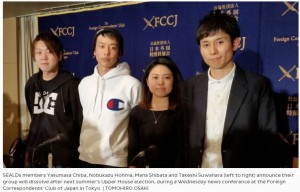 The activist group Students Emergency Action for Liberal Democracy (SEALDs) announced that it would close down next summer after mobilizing youth voters for the upcoming elections for the Upper House of the National Diet, scheduled for summer, 2016. [See below 2015-0919 on SEALDs]
The activist group Students Emergency Action for Liberal Democracy (SEALDs) announced that it would close down next summer after mobilizing youth voters for the upcoming elections for the Upper House of the National Diet, scheduled for summer, 2016. [See below 2015-0919 on SEALDs]
2015-1027: The 21st-century family in crisis?
Apropos of this week’s consideration of ongoing changes in Japanese family formation (or reformation, or deformation…), the NYT has two reports today from other parts of the world. One, representative of the genre of alarmist writing, warns of about immanent demographic collapse in Cuba. The other, from its Sinosphere Blog, from the genre of whackiness, reports a Chinese scholar’s proposal that the Chinese government legalize what anthropologists call polyandry, that is, allow two men to share a single wife. This, he believes, is a creative solution to the growing surplus of young men over young women and the rising numbers of bachelors unable to find wives!
2015-1019: Several online articles on present conditions around the Fukushima nuclear power plant area
David McNeill is a very fine freelance journalist who writes about Japan topics for a number of Western newspapers and magazines. He has written much about the Fukushima nuclear plant disaster and its continuing issues. His most recent posting on the invaluable online journal Asia-Pacific Journal: Japan Focus is “Inside Fukushima’s Potemkin Village: Naraha.” The same issue of the journal has an abbreviated essay by the Polish photographer and journalist Arkadiusz Podniesiński, who did much reporting on Chernobyl and now has turned his attention to the Fukushima region. His article is “Fukushima: The View from Ground Zero.” He has posted a full version on his web site HERE . His many photographs of the radiated zone are striking and disturbing, such as a deserted school gymnasium:
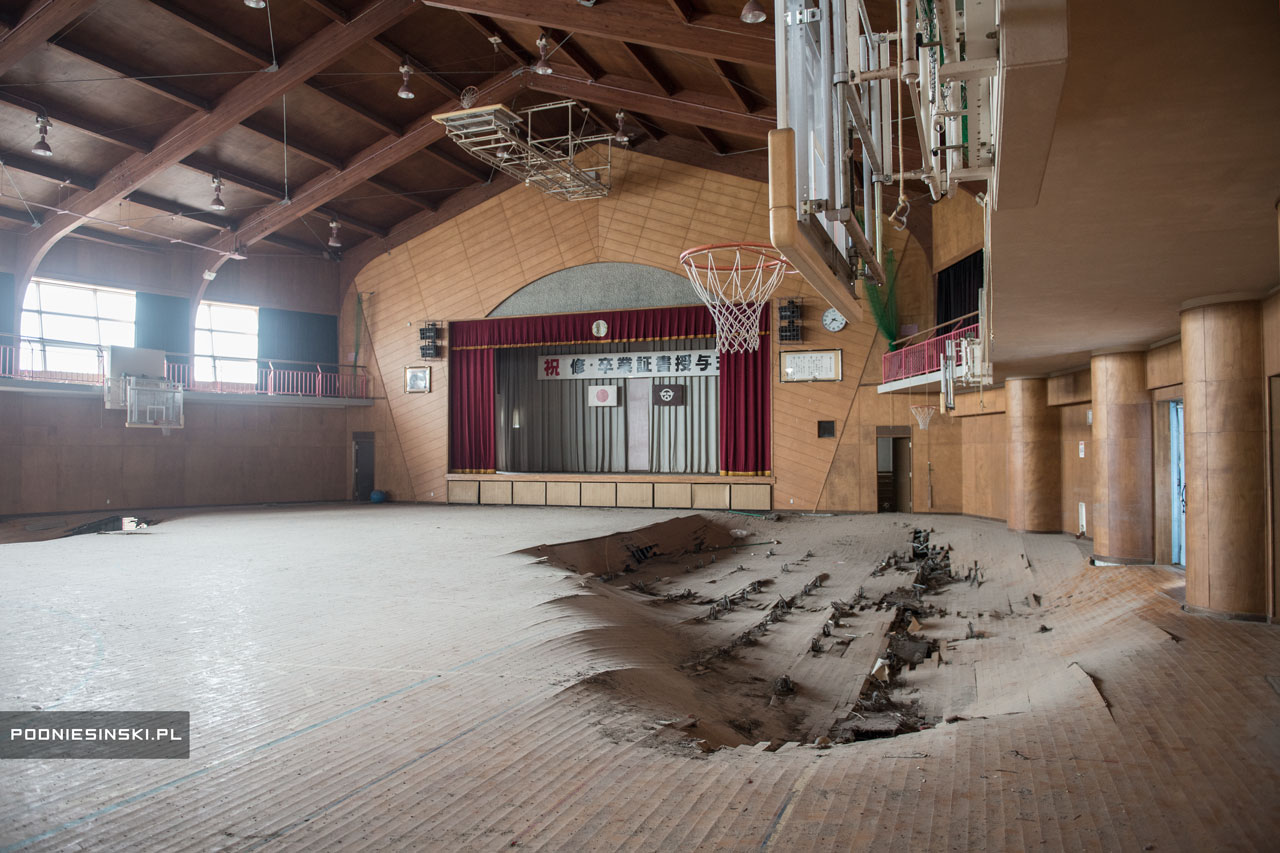
2015-1018: Will spouses be able to retain their birth-family surnames?
“What’s in a name? Japan debates whether to allow spouses to adopt separate surnames” is an informative Japan Times article by staff writer Masami Ito about the background to and the controversy surrounding a constitutional ruling expected soon from Japan’s Supreme Court.
2015-1011: Hoodie Monks mix beats with their Buddhism

Spitting dharma: Hoodie Monk Gomyo raps as a graffiti artist works in the background at the Yugasan Rendaiji Temple in Okayama Prefecture during Eitai Kuyo, an annual service held to honor the dead. | COURTESY OF THE HOODIE MONKS
Article HERE. “Heart Sutra” is HERE
2015-1010: More neoliberalism!
“China just introduced a universal credit score, where everybody is measured as a number between 350 and 950. But this credit score isn’t just affected by how well you manage credit – it also reflects how well your political opinions are in line with Chinese official opinions, and whether your friends’ are, too. …” MORE
2015-1001: U Tokyo falls in World University Rankings announced today.
Article is in Japan Times HERE. The Times of London web site on these rankings and the metrics behind them is HERE.
2015-1001: Blendy Coffee television commercial
Apropos of our discussions of high schools, graduation, and connections to the workforce, Alyssa suggests a satirical commercial from Blendy Coffee that appear on television earlier this year, seen HERE
2015-0919: For more on the SEALDs
Two more articles by the anthropologists David Slater and Robin O’Day have just been published at the online journal Japan Focus:
David Slater, Robin O’Day, Satsuki Uno, Love Kindstrand & Chiharu Takano,
“SEALDs (Students Emergency Action for Liberal Democracy): Research Note on Contemporary Youth Politics in Japan”
Robin O’Day, “Differentiating SEALDs from Freeters, and Precariats: the politics of youth movements in contemporary Japan”
PS: This would be a great topic for any of you contemplating a senior essay in anthro, political science, history, or East Asian Studies
2015-0916: Youth protest in Japan
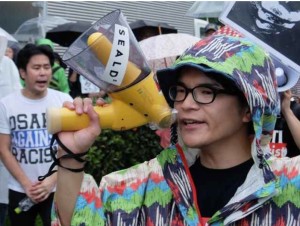 The ongoing anxieties about the Fukushima nuclear reactor disasters, the efforts of the current government under Prime Minister Abe to forcibly legislate a change in Japan’s Constitution to permit Japanese offensive military actions abroad, and the multiple 70th-year anniversaries of 1945 have all sparked significant organized political protest actions this year. Among the most impressive–and surprising–has been the student-youth-centered movement named the SEALDs (Student Emergency Action for Liberal Democracy). It announced itself on May 3 of this year (Japan’s Constitution Day), and it was a major organizer of a mass rally in front of the National Diet Building on August 30, which drew upwards of 100,000 or more. Jeffrey Kingston, a well-known historian and the Director of Asian Studies at Temple University Japan, has a useful profile of SEALDs and the current protests at the online Asia-Pacific Journal: Japan Focus (note that this journal has many articles of much interest for Japan social science and history).
The ongoing anxieties about the Fukushima nuclear reactor disasters, the efforts of the current government under Prime Minister Abe to forcibly legislate a change in Japan’s Constitution to permit Japanese offensive military actions abroad, and the multiple 70th-year anniversaries of 1945 have all sparked significant organized political protest actions this year. Among the most impressive–and surprising–has been the student-youth-centered movement named the SEALDs (Student Emergency Action for Liberal Democracy). It announced itself on May 3 of this year (Japan’s Constitution Day), and it was a major organizer of a mass rally in front of the National Diet Building on August 30, which drew upwards of 100,000 or more. Jeffrey Kingston, a well-known historian and the Director of Asian Studies at Temple University Japan, has a useful profile of SEALDs and the current protests at the online Asia-Pacific Journal: Japan Focus (note that this journal has many articles of much interest for Japan social science and history).
You may also be interested in a new web site, Voices of Protest, organized by Professor David Slater and a number of other professors and students at Tokyo universities. As the site announces: ” Voices of Protest Japan is an online bilingual archive devoted to documenting the variety of political perspectives on the aftermath of the 3.11 disaster.” Of particular note is the collection of interviews they are conducting and posting with a spectrum of citizens involved in many aspects of post-3.11 politics and social action. For those of you studying Japanese language, the interviews are a great way of hearing how current events and concerns are expressed.
2015-0916: Voices from Tōhoku Project
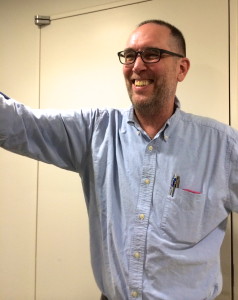 And speaking of Professor Slater, I also strongly recommended the web site that presents the amazing work by him and his students in the tsunami- and Fukushima-devastated towns and villages of Tōhoku. Their project, Voices from Tōhoku 『東北からの声』, is now the largest database of videotaped interviews with residents and others directly affected by the 3.11 disasters. The 400 hours of interviews with over 300 individuals are available for listening and study at the web site.
And speaking of Professor Slater, I also strongly recommended the web site that presents the amazing work by him and his students in the tsunami- and Fukushima-devastated towns and villages of Tōhoku. Their project, Voices from Tōhoku 『東北からの声』, is now the largest database of videotaped interviews with residents and others directly affected by the 3.11 disasters. The 400 hours of interviews with over 300 individuals are available for listening and study at the web site.
2015-0911: From theatlantic.com:
Typhoon Etau Triggers Flooding in Japan
“Unprecedented rain in Japan unleashed heavy floods on Friday that tore houses from their foundations, uprooted trees, and forced more than 100,000 people from their homes,” according to Reuters. One person was missing after rivers burst their banks in cities north of Tokyo following days of heavy rain, caused by Typhoon Etau, pummeling Japan. The Japan Meteorological Agency issued special downpour warnings for Tochigi and Ibaraki prefectures, north of Tokyo, warning of further mudslides and flooding.
A gallery of 34 photos is HERE
2015-0910: Follow-up to Boston Museum of Fine Arts kimono controversy
As you know from the last week’s writing exercise, one of the most helpful and thoughtful commentaries was the blog post by Ms. Keiko Kawabe. She contacted me with some further information and kindly wrote the following: “If your students would like to talk to me I do answer comments on my blog and they can find me on Twitter as well at
https://twitter.com/keikoinboston.” Ms. Kawabe has posted a three-part “post-mortem” of the controversy beginning with Part One HERE.
She also noted that “Some of the protesters organized a panel discussion under the auspices of two local Asian American organizations they are members of (not under Decolonize Our Museums). Dr. Paul Watanabe is an incredible speaker (he’s director of the Institute for Asian American Studies at UMass). The other panelist is Dr. Tajima Creef from Wellesley. .. Here are the details:
https://www.facebook.com/napawfgreaterboston/posts/920478648019008
https://www.facebook.com/events/1213122088714290/”
Ms. Kawabe also recommends this blog post for additional commentary.
Continuing follow-ups:
2015-1009: Ms. Kawabe has provided a valuable, detailed report on a panel discussion held on September 19 at the Massachusetts College of Art that further explores the controversy and the larger issues raised by the museum program and its protests. Her commentary begins HERE
2015-1012: The London-based musician and sub-editor for the New Statesman has a column in the newspaper “In Defense of Cultural Appropriation”
